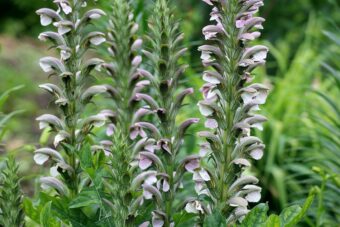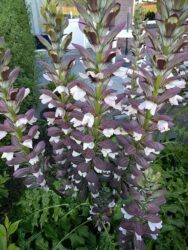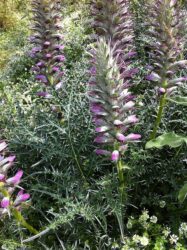In this article, we will be discussing how to grow acanthus in containers. They are wonderful flowering plants that belong to their own family, where 30 species are known to exist. It is native to tropical and warm regions in the Mediterranean and Asia. The flowers are grown for their nectar production and for attracting butterflies.

Acanthus make handsome plants that are grown for their attractive leaves and colourful, impactful flower displays. The deeply-divided arching leaves clothe the bases of the tall spikes of tubular purple and white flowers that appear in midsummer.
This is one plant that will suit bold planting schemes, where the large glossy leaves and flowers can be enjoyed at the back of the group display. One thing that must be considered is that Acanthus are long-lived plants, but they hate to be disturbed at the roots and absolutely hate heavy soils and compost. Once established it will take drought better than other border perennials.
Find out how to grow this delightful plant in containers in this article.
HOW TO GROW ACANTHUS IN POTS
One thing that must be borne in mind is that Acanthus has a long tap-root that make disturbing them difficult in the future. This is why if you use a container, make sure it is the largest possible in terms of diameter and height.

Select a container that meets this criterion and make sure it has plenty of drainage holes in them. To this add a 1cm layer of gravel at the bottom of the container to help with drainage. On top of this add a mixture of 80% by volume of multipurpose compost with 20% by volume of perlite. This will create a light but well-draining growing media.
Dig a hole in the growing media that is slightly bigger than the root ball in the original container. Place the plant in so that the top of the root ball is at the same level as the top of the surface of the compost. Backfill with the growing media, making sure that any gap that remains is filled with more compost. Firm the plant in and water well.
At the time of the planting, it is a good idea to mix a handful of slow-release fertilizer to give a boost for the growing season. Place the container to where it will get as much sunlight as possible, although it can be grown in light shade. In the light shade, it will not look as spectacular as in the full sun.
WATER UNTIL IT IS WELL ESTABLISHED
Water well until the plant is well established but after that, it can take drought to a certain degree. In heatwaves, it will need to be watered regularly especially when it feels dry to the touch. It is a good idea to give an annual dressing with a slow-release fertilizer to help get the plant through the growing season.
As you can imagine the plant will over time get larger and congested and at this time, it is a good idea to divide the plant to get new divisions in early autumn.
After the plant has flowered, you will need to cut the stems to near the base, where in spring the old leaves can be safely removed (especially the old and spent ones).
PESTS AND DISEASES
Luckily the plant does not suffer much in the way of pests or disease, but in hot, dry weather they can suffer from powdery mildew, This is best avoided by having good air circulation on and around the plant and by watering around the roots in hot weather. You can spray with a suitable systemic fungicide if your plant has a bad case of powdery mildew, but this should be avoided as it is easier to prevent than treat it.
VARIETIES TO GROW
Two species are recommended to be grown in containers and are easily found:

Acanthus mollis is a tall perennial with glossy, architectural green leaves and produces attractive white flowers with purple heads in midsummer. A noted variety is ‘Whitewater’ that has leaves with white splashes at the margins. The flowers are pink/creamy white.
The other species is Acanthus spinosus which is smaller than A. mollis in terms of height and leaf size. The green glossy leaves are more finely cut and have spiny tips. The flowers are the same colour but more flowering spikes are produced.
A. ‘Summer Beauty’ is a hybrid between A. spinosis and A. mollis that produces giant glossy, finely divided, dark green foliage. The flowers are similar but are taller in height.
CONCLUSIONS
In this article, we have discussed how to grow Acanthus in containers to give tall spikes of colourful flowers and elegant glossy leaves. They simply look elegant growing in large containers at the back of container displays.
They are easy to look after, only require feeding once a year and watering when it is hot and dry. Dividing the plant is best kept to a minimum and only carried out when the plant has become totally root-bound.
A must for most gardeners to have in their container displays.
If you have any questions or comments that you have on growing acanthus in containers, please do so in the comment box below.
Happy Acanthus growing.

I am growing Whitewater Acanthus in a pot because its not hardy in my area. When should I repot to a larger pot? Its in a 2 gal pot now.
Hi Clara
The answer when to repot is when it becomes root bound in its own container. Once this happens I would pot on to the next pot size up.
Thank you
Antonio
Hi. We have a potted Whitewater Acanthus. Zone 8; drops down to freezing on occasion. Ours is 1 year old. We have read they die back in winter in zone 8 and then reemerge in spring. We have read, also, that is for ground specimens. Is it true for potted as well? Or will freezing kill it? We had a cold snap, and the older growth was hit hard, but young newer growth near the center just above the soil looks great. We thought about bringing it indoors, but don’t have a sunny spot for it; maybe in our garage under florescent? Or would it be better to leave it outdoors? The pot might be a bit small for it. We are getting so many mixed messages (location is an hour North of Seattle near the Canadian Border). https://mycontainergardener.com/growing-acanthus-in-containers-growing-bears-breeches/
Hi Norm
They can take hardy frosts pretty well but if you want to protect them, you can cover them with horticultural fleece or bubble wrap. As long as they do not get too wet then it should be okay.
Thanks
Antonio